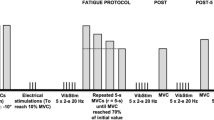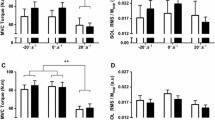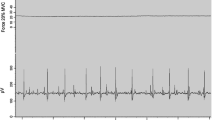Abstract
Purpose
This study was designed to investigate whether the intensity modulation of a neuromuscular electrical stimulation (NMES) protocol delivered over the nerve trunk of the plantar flexors would lead to differential peripheral and central contributions of muscle fatigue.
Methods
Three fatiguing isometric protocols of the plantar flexors matched for the same amount of isometric torque-time integral (TTI) were randomly performed including a volitional protocol at 20 % of the maximal voluntary contraction (MVC) and two NMES protocols (one at constant intensity, CST; the other at intensity level progressively adjusted to maintain 20 % of MVC, PROG).
Results
No time x protocol interaction was found for any of the variables. The MVC decreased similarly (≈12 %, p < 0.001) after all protocols, so did the potentiated twitch responses (p = 0.001). Although voluntary activation of the plantar flexors did not change, maximal H-reflex to M-wave ratio of the soleus (SOL) and the gastrocnemius medialis (GM) muscles showed an overall increase (SOL: p = 0.037, GM: p = 0.041), while it remained stable for the gastrocnemius lateralis muscle (p = 0.221). A main time effect was observed only for the SOL maximal V-wave to the superimposed M-wave ratio (p = 0.024) and to the superimposed H-reflex (p = 0.008). While similar central and peripheral adaptations were observed after the three fatiguing protocols, the individual contribution of the three different triceps surae muscles was different.
Conclusion
Whether the current intensity was increased or not, the adaptations after a NMES protocol yield to similar muscle fatigue adaptations as voluntary contractions likely through similar pathways matching a similar TTI.





Similar content being viewed by others
References
Aagaard P, Simonsen EB, Andersen JL et al (2002) Neural adaptation to resistance training: changes in evoked V-wave and H-reflex responses. J Appl Physiol 92:2309–2318
Adams GR, Harris RT, Woodard D, Dudley GA (1993) Mapping of electrical muscle stimulation using MRI. J Appl Physiol 74:532–537
Allen GM, Gandevia SC, McKenzie DK (1995) Reliability of measurements of muscle strength and voluntary activation using twitch interpolation. Muscle Nerve 18:593–600
Allen DG, Lamb GD, Westerblad H (2008) Skeletal muscle fatigue: cellular mechanisms. Physiol Rev 88:287–332
Baldwin ERL, Klakowicz PM, Collins DF (2006) Wide-pulse-width, high-frequency neuromuscular stimulation: implications for functional electrical stimulation. J Appl Physiol 101:228–240
Bawa P, Murnaghan C (2009) Motor unit rotation in a variety of human muscles. J Neurophysiol 102:2265–2272
Bawa P, Pang MY, Olesen KA, Calancie B (2006) Rotation of motoneurons during prolonged isometric contractions in humans. J Neurophysiol 96:1135–1140
Bax L, Staes F, Verhagen A (2005) Does neuromuscular electrical stimulation strengthen the quadriceps femoris? A systematic review of randomised controlled trials. Sports Med 35:191–212
Bergquist AJ, Clair JM, Collins DF (2011a) Motor unit recruitment when neuromuscular electrical stimulation is applied over a nerve trunk compared with a muscle belly: triceps surae. J Appl Physiol 110:627–637
Bergquist AJ, Clair JM, Lagerquist O et al (2011b) Neuromuscular electrical stimulation: implications of the electrically evoked sensory volley. Eur J Appl Physiol 111:2409–2426
Bergquist AJ, Wiest MJ, Collins DF (2012) Motor unit recruitment when neuromuscular electrical stimulation is applied over a nerve trunk compared with a muscle belly: quadriceps femoris. J Appl Physiol 113:78–89
Bergström M, Hultman E (1988) Energy cost and fatigue during intermittent electrical stimulation of human skeletal muscle. J Appl Physiol 65:1500–1505
Binder-Macleod SA, Scott WB (2001) Comparison of fatigue produced by various electrical stimulation trains. Acta Physiol Scand 172:195–203
Boerio D, Jubeau M, Zory R, Maffiuletti NA (2005) Central and peripheral fatigue after electrostimulation-induced resistance exercise. Med Sci Sports Exerc 37:973–978
Burridge JH, Ladouceur M (2001) Clinical and therapeutic applications of neuromuscular stimulation: a review of current use and speculation into future developments. Neuromodulation 4:147–154
Collins DF (2007) Central contributions to contractions evoked by tetanic neuromuscular electrical stimulation. Exerc Sport Sci Rev 35:102–109
Colson SS, Benchortane M, Tanant V et al (2010) Neuromuscular electrical stimulation training: a safe and effective treatment for facioscapulohumeral muscular dystrophy patients. Arch Phys Med Rehabil 91:697–702
Dean JC, Yates LM, Collins DF (2007) Turning on the central contribution to contractions evoked by neuromuscular electrical stimulation. J Appl Physiol 103:170–176
Enoka RM, Duchateau J (2008) Muscle fatigue: what, why and how it influences muscle function. J Physiol (Lond) 586:11–23
Fuglevand AJ, Zackowski KM, Huey KA, Enoka RM (1993) Impairment of neuromuscular propagation during human fatiguing contractions at submaximal forces. J Physiol (Lond) 460:549–572
Gandevia SC (2001) Spinal and supraspinal factors in human muscle fatigue. Physiol Rev 81:1725–1789
Gondin J, Guette M, Ballay Y, Martin A (2005) Electromyostimulation training effects on neural drive and muscle architecture. Med Sci Sports Exerc 37:1291–1299
Gondin J, Duclay J, Martin A (2006) Soleus-and gastrocnemii-evoked V-wave responses increase after neuromuscular electrical stimulation training. J Neurophysiol 95:3328–3335
Gondin J, Giannesini B, Vilmen C et al (2010) Effects of stimulation frequency and pulse duration on fatigue and metabolic cost during a single bout of neuromuscular electrical stimulation. Muscle Nerve 41:667–678
Gorgey AS, Black CD, Elder CP, Dudley GA (2009) Effects of electrical stimulation parameters on fatigue in skeletal muscle. J Orthop Sports Phys Ther 39:684–692
Gregory CM, Bickel CS (2005) Recruitment patterns in human skeletal muscle during electrical stimulation. Phys Ther 85:358–364
Gregory CM, Dixon W, Bickel CS (2007) Impact of varying pulse frequency and duration on muscle torque production and fatigue. Muscle Nerve 35:504–509
Grosprêtre S, Martin A (2012) H reflex and spinal excitability: methodological considerations. J Neurophysiol 107:1649–1654
Hagbarth KE (1962) Post-tetanic potentiation of myotatic reflexes in man. J Neurol Neurosurg Psychiatr 25:1–10
Hamdy S, Rothwell JC, Aziz Q et al (1998) Long-term reorganization of human motor cortex driven by short-term sensory stimulation. Nat Neurosci 1:64–68
Henneman E, Somjen G, Carpenter DO (1965) Excitability and inhabitability of motoneurons of different sizes. J Neurophysiol 28:599–620
Herbert RD, Gandevia SC (1999) Twitch interpolation in human muscles: mechanisms and implications for measurement of voluntary activation. J Neurophysiol 82:2271–2283
Hermens HJ, Freriks B, Disselhorst-Klug C, Rau G (2000) Development of recommendations for SEMG sensors and sensor placement procedures. J Electromyogr Kinesiol 10:361–374
Hirst GD, Redman SJ, Wong K (1981) Post-tetanic potentiation and facilitation of synaptic potentials evoked in cat spinal motoneurones. J Physiol (Lond) 321:97–109
Hultman E, Sjöholm H, Jäderholm-Ek I, Krynicki J (1983) Evaluation of methods for electrical stimulation of human skeletal muscle in situ. Pflugers Arch 398:139–141
Jones DA (1996) High-and low-frequency fatigue revisited. Acta Physiol Scand 156:265–270
Kebaetse MB, Binder-Macleod SA (2004) Strategies that improve human skeletal muscle performance during repetitive, non-isometric contractions. Pflugers Arch 448:525–532
Kesar T, Chou L-W, Binder-Macleod SA (2008) Effects of stimulation frequency versus pulse duration modulation on muscle fatigue. J Electromyogr Kinesiol 18:662–671
Kiernan MC, Lin CS-Y, Burke D (2004) Differences in activity-dependent hyperpolarization in human sensory and motor axons. J Physiol (Lond) 558:341–349
Kitago T, Mazzocchio R, Liuzzi G, Cohen LG (2004) Modulation of H-reflex excitability by tetanic stimulation. Clin Neurophysiol 115:858–861
Klakowicz PM, Baldwin ERL, Collins DF (2006) Contribution of M-waves and H-reflexes to contractions evoked by tetanic nerve stimulation in humans. J Neurophysiol 96:1293–1302
Kufel TJ, Pineda LA, Mador MJ (2002) Comparison of potentiated and unpotentiated twitches as an index of muscle fatigue. Muscle Nerve 25:438–444
Lagerquist O, Collins DF (2010) Influence of stimulus pulse width on M-waves, H-reflexes, and torque during tetanic low-intensity neuromuscular stimulation. Muscle Nerve 42:886–893
Lévénez M, Kotzamanidis C, Carpentier A, Duchateau J (2005) Spinal reflexes and co-activation of ankle muscles during a submaximal fatiguing contraction. J Appl Physiol 99:1182–1188
Lloyd DPC (1949) Post-tetanic potentiation of response in monosynaptic reflex pathways of the spinal cord. J Gen Physiol 33:147–170
Maffiuletti NA (2010) Physiological and methodological considerations for the use of neuromuscular electrical stimulation. Eur J Appl Physiol 110:223–234
Matsunaga T, Shimada Y, Sato K (1999) Muscle fatigue from intermittent stimulation with low and high frequency electrical pulses. Arch Phys Med Rehabil 80:48–53
Miles GB, Dai Y, Brownstone RM (2005) Mechanisms underlying the early phase of spike frequency adaptation in mouse spinal motoneurones. J Physiol (Lond) 566:519–532
Millet GY, Martin V, Martin A, Vergès S (2011) Electrical stimulation for testing neuromuscular function: from sport to pathology. Eur J Appl Physiol 111:2489–2500
Muthalib M, Jubeau M, Millet GY et al (2010) Biceps brachii muscle oxygenation in electrical muscle stimulation. Clin Physiol Funct Imaging 30:360–368
Papaiordanidou M, Guiraud D, Varray A (2010) Kinetics of neuromuscular changes during low-frequency electrical stimulation. Muscle Nerve 41:54–62
Perez MA, Field-Fote EC, Floeter MK (2003) Patterned sensory stimulation induces plasticity in reciprocal Ia inhibition in humans. J Neurosci 23:2014–2018
Pierrot-Deseilligny E, Mazevet D (2000) The monosynaptic reflex: a tool to investigate motor control in humans. Interest and limits. Neurophysiol Clin 30:67–80
Russ DW, Elliott MA, Vandenborne K et al (2002a) Metabolic costs of isometric force generation and maintenance of human skeletal muscle. Am J Physiol Endocrinol Metab 282:E448–E457
Russ DW, Vandenborne K, Binder-Macleod SA (2002b) Factors in fatigue during intermittent electrical stimulation of human skeletal muscle. J Appl Physiol 93:469–478
Scaglioni G, Martin A (2009) Assessment of plantar flexors activation capacity: nerve versus muscle stimulation by single versus double pulse. Eur J Appl Physiol 106:563–572
Schieppati M (1987) The Hoffmann reflex: a means of assessing spinal reflex excitability and its descending control in man. Prog Neurobiol 28:345–376
Shield A, Zhou S (2004) Assessing voluntary muscle activation with the twitch interpolation technique. Sports Med 34:253–267
Strojnik V, Komi PV (1998) Neuromuscular fatigue after maximal stretch-shortening cycle exercise. J Appl Physiol 84:344–350
Taylor JL (2009) Point:Counterpoint: the interpolated twitch does/does not provide a valid measure of the voluntary activation of muscle. J Appl Physiol 107:354–355
Theurel J, Lepers R, Pardon L, Maffiuletti NA (2007) Differences in cardiorespiratory and neuromuscular responses between voluntary and stimulated contractions of the quadriceps femoris muscle. Respir Physiol Neurobiol 157:341–347
Tucker KJ, Tuncer M, Türker KS (2005) A review of the H-reflex and M-wave in the human triceps surae. Hum Mov Sci 24:667–688
Upton AR, McComas AJ, Sica RE (1971) Potentiation of “late” responses evoked in muscles during effort. J Neurol Neurosurg Psychiatr 34:699–711
Vanderthommen M, Depresseux JC, Dauchat L et al (2000) Spatial distribution of blood flow in electrically stimulated human muscle: a positron emission tomography study. Muscle Nerve 23:482–489
Vanderthommen M, Duteil S, Wary C et al (2003) A comparison of voluntary and electrically induced contractions by interleaved 1H- and 31P-NMRS in humans. J Appl Physiol 94:1012–1024
Vilin YY, Ruben PC (2001) Slow inactivation in voltage-gated sodium channels: molecular substrates and contributions to channelopathies. Cell Biochem Biophys 35:171–190
Westerblad H, Allen DG, Lännergren J (2002) Muscle fatigue: lactic acid or inorganic phosphate the major cause? News Physiol Sci 17:17–21
Zehr EP (2002) Considerations for use of the Hoffmann reflex in exercise studies. Eur J Appl Physiol 86:455–468
Acknowledgments
This project was supported by the bilateral researcher exchange program Aurora, financed by the Norwegian Research Council and the French Ministry of Foreign affairs (Grant number: 27407SG) (http://www.campusfrance.org/fr/aurora). The funders had no role in study design, data collection and analysis, decision to publish, or preparation of the manuscript.
Conflict of interest
The authors declare that they have no conflict of interest.
Author information
Authors and Affiliations
Corresponding author
Additional information
Communicated by Toshio Moritani.
Rights and permissions
About this article
Cite this article
Doix, AC.M., Matkowski, B., Martin, A. et al. Effect of neuromuscular electrical stimulation intensity over the tibial nerve trunk on triceps surae muscle fatigue. Eur J Appl Physiol 114, 317–329 (2014). https://doi.org/10.1007/s00421-013-2780-y
Received:
Accepted:
Published:
Issue Date:
DOI: https://doi.org/10.1007/s00421-013-2780-y




